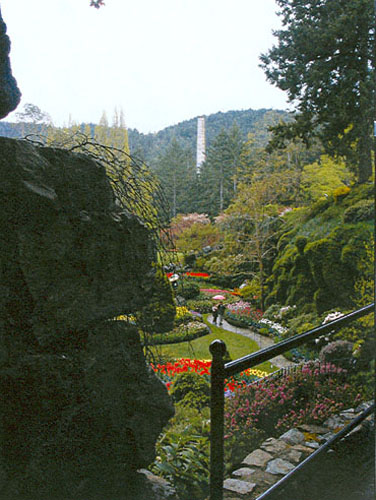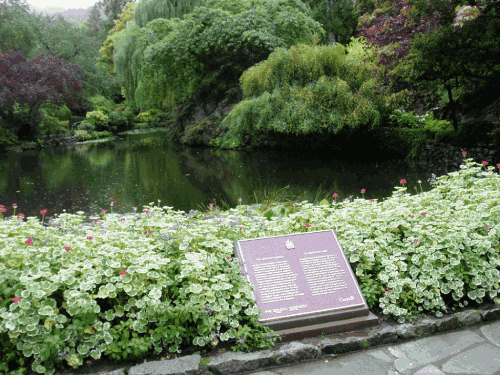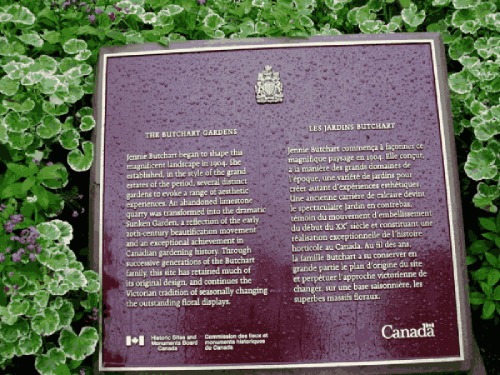Butchart Gardens National Historic Site
The Butchart gardens were designated a national historic site in 2004.
Commemorative plaque: 800 Benvenuto Drive, Saanichton, British ColumbiaFootnote 1
Jennie Butchart began to shape this magnificent landscape in 1904. She established, in the style of the grand estates of the period, several distinct gardens to evoke a range of aesthetic experiences. An abandoned limestone quarry was transformed into the dramatic Sunken Garden, a reflection of the early 20th-century beautification movement and an exceptional achievement in Canadian gardening history. Through successive generations of the Butchart family, this site has retained much of its original design, and continues the Victorian tradition of seasonally changing the outstanding floral displays.
Description of historic place
Butchart Gardens National Historic Site of Canada is an internationally-known public attraction that has been open to visitors since 1904. It is located on the Saanich Peninsula, approximately 21 kilometres north of Victoria, British Columbia. The gardens occupy the site of a former quarry and borders on Tod Inlet. The designated area of the gardens occupies approximately 5.26 hectares and corresponds to the areas developed under the guidance of Jennie Butchart between 1904 and 1939. The gardens provide dramatic floral displays in a variety of garden settings and styles set against a backdrop of mature trees and shrubs and linked together by a network of paths and transition areas. Throughout the garden are viewpoints offering glimpses of Tod Inlet and the hills beyond. Official recognition generally corresponds with the historic gardens laid out by Mrs. Jennie Butchart between 1904 and 1939, and includes the residence that was remodeled and enlarged for the Butchart’s by architect Samuel Maclure.

© Parks Canada/A. Mosquin, 2004


Heritage value
Butchart Gardens was designated a National Historic Site of Canada in 2004 because:
- it represents the remarkable combination of three aspects of Canadian gardening history. First, the gardens represent the traits of an early 20th-century estate garden through its different types of gardens such as the Japanese Garden, the Rose Garden, the Italian Garden, the Star Pond and Jennie Butchart's Private Garden. Second, the gardens evoke the early twentieth century beautification movement as expressed through the Sunken Garden. And third, the gardens rely upon the Victorian bedding out system to achieve their outstanding floral displays. These three aspects of the Butchart Gardens have been conveyed through the successive visions of Butchart family members, notably Jennie Butchart and Ian Ross;
- the transformation of a limestone quarry into a sunken garden of massive dimensions and dramatic aesthetic qualities represents an exceptional creative achievement in Canadian gardening history. Moreover, as the garden has matured and evolved, its beauty has become more distinctive.

© Parks Canada/M. Trépannier, 2001
The layout of the gardens as a series of clearly defined spaces or “rooms,” each with its own character and style, was characteristic of Edwardian landscape design. The largest and most distinctive of these is the Sunken Garden, which occupies the former limestone quarry. Accessed by a switchback staircase that leads 15 metres (50 feet) down to the undulating floor of this garden, the initial core of the landscaping process begun by Jennie Butchart. The garden floor contains beds of annuals interspersed amongst flowering trees and shrubs planted up to the base of the towering quarry walls crowned by mature Douglas firs, cedars and Lombardy poplars. Other spaces include the Rose Garden featuring beds of hybrid tea roses, rose arches, and boxwood hedges; the Japanese Garden begun in 1906 by Jennie Butchart and Japanese landscaper Isaburo Kishida with its complex network of interconnected ponds criss-crossed by paths and bridges, moss-covered ground surfaces, bamboo, and meticulously pruned-trees and shrubs; the Star Pond as a formal water feature in the shape of a twelve-pointed star interspersed with beds of annual flowers with a frog fountain as its centre-piece; the Italian Garden, a formal sunken garden defined by a rectangular concrete terrace that encloses a cross-shaped water feature.
The Butchart residence is evidence that these beautiful gardens were once part of a private family estate. Originally a small summer residence, this rambling bungalow was enlarged and remodeled through renovations carried out between 1911 and 1925 to plans by celebrated west coast architect Samuel Maclure. This former residence is flanked by a broad patio area known as the Piazza, the Italian Garden, and by Jennie Butchart’s original private garden. The latter is a small formal garden containing flowerbeds, a gazebo and a pond that is enclosed by latticed fences.
Source: Historic Sites and Monuments Board of Canada, Minutes, June 2004.
The National Program of Historical Commemoration relies on the participation of Canadians in the identification of places, events and persons of national historic significance. Any member of the public can nominate a topic for consideration by the Historic Sites and Monuments Board of Canada.
- Date modified :